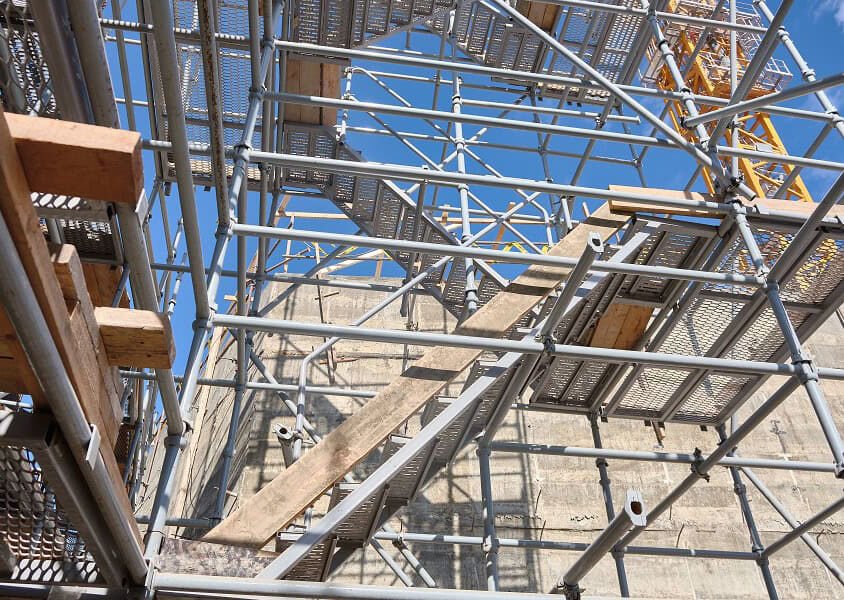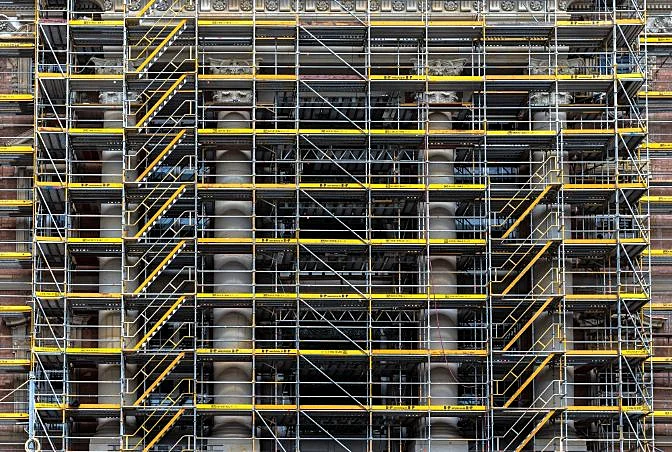Residential Scaffolding Solutions for Safe and Efficient Home Improvements
Residential Scaffolding Solutions for Safe and Efficient Home Improvements
Blog Article
The Perks of Scaffolding for Safety And Security and Efficiency in Structure Projects
Scaffolding is a vital element in the realm of construction, significantly adding to both safety and security and functional performance. The effect of scaffolding expands beyond basic safety and security actions; its strategic implementation can change job timelines and end results (Scaffolding).
Improved Employee Safety

Boosted employee safety and security is a critical problem in the building sector, where the risks related to drops and mishaps can have alarming consequences. Reliable scaffolding systems play an important function in minimizing these threats by giving stable platforms for employees at raised elevations. By guaranteeing that scaffolding is appropriately erected and maintained, building and construction business can substantially decrease the probability of drops, which are amongst the leading causes of workplace injuries and casualties.
In addition, scaffolding boosts safety and security via its layout functions. Guardrails, toe boards, and non-slip surfaces contribute to a protected functioning setting, lessening the danger of mishaps. Additionally, scaffolding allows employees to gain access to hard-to-reach areas without the need for makeshift options, which can jeopardize safety standards.
Educating workers on the proper usage of scaffolding is similarly essential. Guaranteeing that personnel are well-informed about lots capabilities, setting up treatments, and security protocols additionally improves the effectiveness of scaffolding in avoiding accidents. To conclude, integrating robust scaffolding systems within building and construction jobs not only boosts worker safety and security however likewise promotes a culture of safety and security that benefits the entire labor force while improving total efficiency.
Improved Accessibility and Mobility

Moreover, scaffolding enables for the hassle-free transportation of devices and products, decreasing downtime connected with relocating tools. Workers can effectively access numerous locations of a project, which is especially important in complicated builds where upright and straight movement is regular - Scaffolding. This access not only improves procedures yet also enables groups to react quickly to altering job needs
In addition, scaffolding can be tailored to accommodate certain website problems, enhancing movement in limited or irregular rooms. This flexibility makes sure that building and construction tasks can continue efficiently, no matter the challenges presented by the environment. By fostering improved access and mobility, scaffolding plays a vital duty in sustaining building staffs and maximizing the total performance of structure jobs.
Enhanced Project Efficiency
In building and construction, task performance is dramatically affected by the efficient usage of scaffolding systems. By supplying a steady and protected system for workers, scaffolding reduces downtime and accelerates the rate of building activities. With better access to elevated job areas, groups can complete tasks quicker, minimizing the general job timeline.
The modular nature of modern scaffolding enables fast setting up and disassembly, allowing swift changes between various phases of a project. This adaptability not just improves operations however also adds to better control among various professions, as numerous teams can function concurrently on different areas of a framework.
Moreover, scaffolding guarantees that employees are positioned correctly to execute their tasks without unnecessary pressure or risk of injury, therefore decreasing the chance of accidents that can cause costly delays. Boosted safety measures installed in scaffolding systems, such as guardrails and toe boards, more support reliable operations by preserving employee concentrate on the job at hand as opposed to security issues.

Flexibility for Different Projects
Scaffolding systems attract attention for their adaptability across a vast array of construction tasks, efficient in conference certain website demands and tasks. Their modular layout allows for fast adjustments to fit different building kinds, from household to commercial frameworks, making certain that employees have safe access at various heights and angles.
These systems can be tailored for varied applications, such as frontage work, indoor improvements, or durable industrial tasks. As an example, lightweight light weight aluminum scaffolds are excellent for interior work, while durable steel frameworks supply the needed support for massive construction. The convenience of scaffolding encompasses its capability to be configured for both temporary and long-term frameworks, allowing contractors to effectively intend and perform their jobs.
Moreover, scaffolding can be utilized in tough environments, consisting of city settings where area is minimal or on uneven terrain where typical access remedies are impractical. This versatility reduces the demand for multiple access options, lowering costs and job timelines. By suiting a variety of conditions and tasks, scaffolding boosts the total efficiency and efficiency of building and construction initiatives, proving to be a crucial asset in the building industry.
Compliance With Security Criteria
Just how can building and construction jobs guarantee the safety of employees while preserving efficiency? Governing frameworks, such as OSHA in the United States, provide standards that control the use of scaffolding, ensuring that it fulfills strict safety standards.
Appropriate scaffolding design and setup play an essential function in conformity. Scaffolds should be created from high-grade materials and made to stand up to the certain loads they will certainly experience. Normal evaluations and upkeep are important to ensure that these structures continue to be safe throughout the job duration. Training employees on safe scaffold use and the relevance of conformity with safety requirements further strengthens a culture of security on-site.
Furthermore, documents and record-keeping related to security assessments and employee training are essential. These practices not only demonstrate compliance however also supply liability and openness. Inevitably, by focusing Domestic scaffolding on adherence to safety and security standards, construction projects can foster a safer work atmosphere, consequently boosting efficiency and effectiveness without jeopardizing employee security.
Final Thought
In final thought, scaffolding offers as an important part in building tasks, substantially enhancing security and efficiency. Adherence to security criteria highlights the importance of scaffolding in accomplishing successful project results, making it indispensable in the building industry.
Scaffolding is a crucial component in the world of building and construction, significantly adding to both safety and security and operational effectiveness. The influence of scaffolding prolongs past basic security actions; its critical implementation can change task timelines and outcomes. In final thought, integrating durable scaffolding systems within construction jobs not just improves worker security however additionally advertises a culture of safety that benefits the entire workforce while improving total performance.
In conclusion, scaffolding serves as a crucial part in structure tasks, significantly improving security and effectiveness. Adherence to safety and security criteria emphasizes the importance of scaffolding in accomplishing effective project results, making it indispensable in the construction industry.
Report this page